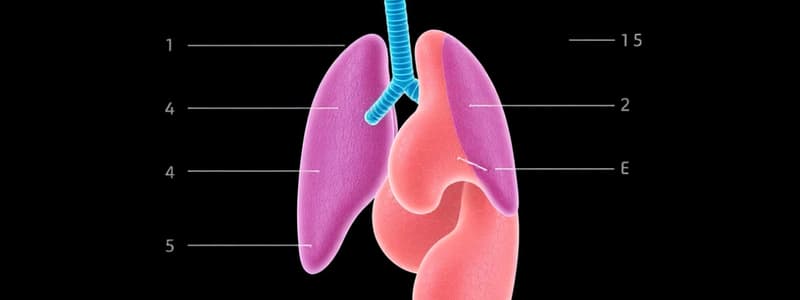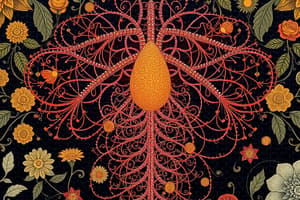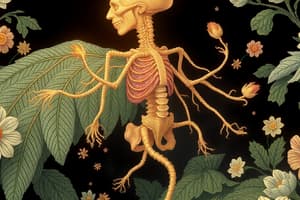Podcast
Questions and Answers
Which of the following characteristics distinguishes unsaturated fatty acids from saturated fatty acids?
Which of the following characteristics distinguishes unsaturated fatty acids from saturated fatty acids?
- Being solid at room temperature.
- Higher proportion in animal products.
- Presence of a carboxyl group at one end.
- Presence of at least one double or triple bond between carbon atoms. (correct)
If a molecule is described as amphipathic, which of the following structural features would you expect it to possess?
If a molecule is described as amphipathic, which of the following structural features would you expect it to possess?
- A long hydrocarbon tail only.
- Both hydrophilic and hydrophobic regions. (correct)
- Four interconnected carbon rings.
- A phosphate group attached to a monoglyceride.
Which of the following best describes the primary role of triglycerides in the human body?
Which of the following best describes the primary role of triglycerides in the human body?
- Serving as energy reserves, insulation, and protection. (correct)
- Regulating hormonal activity.
- Forming the structural components of cell membranes.
- Facilitating the digestion of fats.
Estrogen, testosterone, and progesterone are examples of which type of lipid?
Estrogen, testosterone, and progesterone are examples of which type of lipid?
What type of bond is responsible for linking amino acids together to form a protein?
What type of bond is responsible for linking amino acids together to form a protein?
Which of the following polysaccharides is indigestible by humans and serves as fiber in the diet?
Which of the following polysaccharides is indigestible by humans and serves as fiber in the diet?
A diet rich in animal products is most likely to increase the levels of which type of fatty acid in the body?
A diet rich in animal products is most likely to increase the levels of which type of fatty acid in the body?
How would the properties of a phospholipid change if its phosphate group were replaced with a hydrophobic molecule?
How would the properties of a phospholipid change if its phosphate group were replaced with a hydrophobic molecule?
How would a mutation that prevents the formation of disulfide bridges in a protein affect its overall structure?
How would a mutation that prevents the formation of disulfide bridges in a protein affect its overall structure?
During strenuous exercise, when oxygen supply is limited, what process allows cells to continue generating ATP and what is a notable byproduct?
During strenuous exercise, when oxygen supply is limited, what process allows cells to continue generating ATP and what is a notable byproduct?
Which level of protein structure is determined directly by the sequence of amino acids?
Which level of protein structure is determined directly by the sequence of amino acids?
During protein synthesis, what ensures the correct amino acid is added to the growing polypeptide chain?
During protein synthesis, what ensures the correct amino acid is added to the growing polypeptide chain?
Which of the following statements correctly describes the role of mRNA in protein synthesis?
Which of the following statements correctly describes the role of mRNA in protein synthesis?
If a protein is composed of multiple polypeptide chains, which level of protein structure describes the arrangement of these chains?
If a protein is composed of multiple polypeptide chains, which level of protein structure describes the arrangement of these chains?
After glycolysis, what is the next major step in aerobic glucose catabolism, and where does it take place?
After glycolysis, what is the next major step in aerobic glucose catabolism, and where does it take place?
How does the structure of DNA relate to its function of storing genetic information?
How does the structure of DNA relate to its function of storing genetic information?
What is the primary function of the electron transport chain in glucose catabolism?
What is the primary function of the electron transport chain in glucose catabolism?
During periods of fasting, starvation, or intense exercise, which process helps maintain blood glucose levels, and where does this process primarily occur?
During periods of fasting, starvation, or intense exercise, which process helps maintain blood glucose levels, and where does this process primarily occur?
In a DNA molecule, if 30% of the bases are adenine (A), what percentage of the bases are guanine (G)?
In a DNA molecule, if 30% of the bases are adenine (A), what percentage of the bases are guanine (G)?
How is genetic information transmitted from the nucleus to the cytoplasm for protein synthesis?
How is genetic information transmitted from the nucleus to the cytoplasm for protein synthesis?
What role does tRNA play during protein synthesis?
What role does tRNA play during protein synthesis?
In the context of energy production, what is the correct net ATP production from glycolysis, considering the ATP investment phase?
In the context of energy production, what is the correct net ATP production from glycolysis, considering the ATP investment phase?
What is the primary role of tRNA in protein synthesis?
What is the primary role of tRNA in protein synthesis?
What is the Cori cycle, and what is its primary function?
What is the Cori cycle, and what is its primary function?
Flashcards
Functions of Proteins
Functions of Proteins
Proteins serve various roles: structural, contractile, hormonal, enzymatic, immune, and transport functions.
Structural Proteins
Structural Proteins
Proteins that provide support and framework to body tissues, such as collagen and keratin.
Contractile Proteins
Contractile Proteins
Proteins that facilitate muscle contraction, including actin and myosin.
Hormonal Proteins
Hormonal Proteins
Signup and view all the flashcards
Enzymes
Enzymes
Signup and view all the flashcards
Primary Structure of Proteins
Primary Structure of Proteins
Signup and view all the flashcards
Secondary Structure of Proteins
Secondary Structure of Proteins
Signup and view all the flashcards
Nucleic Acids
Nucleic Acids
Signup and view all the flashcards
Types of RNA
Types of RNA
Signup and view all the flashcards
Messenger RNA (mRNA)
Messenger RNA (mRNA)
Signup and view all the flashcards
Transfer RNA (tRNA)
Transfer RNA (tRNA)
Signup and view all the flashcards
Ribosomal RNA (rRNA)
Ribosomal RNA (rRNA)
Signup and view all the flashcards
Glucose Catabolism
Glucose Catabolism
Signup and view all the flashcards
Anaerobic Glycolysis
Anaerobic Glycolysis
Signup and view all the flashcards
Citric Acid Cycle
Citric Acid Cycle
Signup and view all the flashcards
Gluconeogenesis
Gluconeogenesis
Signup and view all the flashcards
Lipids
Lipids
Signup and view all the flashcards
Saturated fatty acids
Saturated fatty acids
Signup and view all the flashcards
Unsaturated fatty acids
Unsaturated fatty acids
Signup and view all the flashcards
Triglycerides
Triglycerides
Signup and view all the flashcards
Phospholipids
Phospholipids
Signup and view all the flashcards
Steroids
Steroids
Signup and view all the flashcards
Proteins
Proteins
Signup and view all the flashcards
Essential amino acids
Essential amino acids
Signup and view all the flashcards
Study Notes
Levels of Organization
- Atoms and molecules are the basic chemical building blocks (e.g., proteins, lipids, carbohydrates, nucleic acids).
- Cells are the basic units of life. Unicellular organisms consist of one cell, while multicellular organisms have multiple cells.
- Tissues are groups of similar cells working together to perform specific functions (e.g., epithelial, connective, muscle, nervous tissue).
- Organs are structures composed of various tissues performing a specific role (e.g., heart, lungs, skin, stomach).
- Organ systems are groups of organs working together (e.g., cardiovascular, respiratory, digestive systems).
- An organism is the complete living being composed of organ systems interacting.
Homeostasis
- Homeostasis is the body's ability to maintain a stable internal environment despite external changes (e.g., temperature, blood glucose, pH).
- Homeostasis is maintained via feedback loops involving receptors, control centers (e.g., brain), and effectors.
- Disturbed homeostasis results in illness, disease, and even death.
Feedback Loops
- Feedback loops maintain homeostasis by detecting changes and initiating corrective processes.
- Factors like heart rate (HR) are monitored by sensors.
- Controlled centers like the brain process information and initiate responses.
- Effectors restore conditions to their normal values.
- Typically feedback mechanisms are negative, meaning they work to reverse a change.
Anatomical Planes
- Sagittal Plane: divides the body into right and left portions.
- Frontal Plane: divides the body into anterior (front) and posterior (back) portions.
- Transverse Plane: divides the body into superior (upper) and inferior (lower) portions.
Chemical Bonds
- Atoms form chemical bonds to achieve a stable electron configuration (octet rule).
- Atoms with incomplete outer shells are reactive and want to bond.
- Ionic bonds occur from the exchange of electrons, forming positively and negatively charges ion.
- Covalent bonds form when atoms share pairs of electrons.
- Hydrogen bonds are weak attractions between a hydrogen atom and an electronegative atom like oxygen or nitrogen.
Chemical Reactions
- Chemical reactions involve breaking and forming chemical bonds, either releasing or requiring energy.
- Catabolism involves breaking down molecules and releasing energy.
- Anabolism involves building molecules and requiring energy.
- Decomposition reactions break down complex molecules into smaller ones.
- Synthesis reactions combine small molecules to form larger ones (dehydration synthesis).
Water Properties
- Water is a polar molecule with unequal electron sharing, resulting in partial charges.
- Water is a universal solvent, dissolving many ionic and polar compounds.
- Water has a high heat capacity (ability to absorb heat without large temperature increases.)
- Water has a high heat of vaporization requiring a lot of energy to turn into gas.
- Water molecules exhibit cohesion and adhesion. Cohesion is the attraction between like molecules (e.g., water and water.) Adhesion is the attraction between unlike molecules (e.g., water and a glass surface.)
- Water has surface tension due to the hydrogen bonding between water molecules.
Organic Compounds
- Carbohydrates: primary energy source; composed of carbon, hydrogen, and oxygen; often in a (CH₂O)n ratio.
- Monosaccharides (simple sugars): building blocks (glucose).
- Disaccharides (double sugars): formed from two monosaccharides (sucrose).
- Polysaccharides (complex carbohydrates): long chains of monosaccharides (starch, glycogen, cellulose).
- Lipids: diverse hydrophobic group; composed primarily of carbon and hydrogen; insoluble in water.
- Fatty acids: unbranched hydrocarbon chains with a carboxyl group; saturated (no double bonds) or unsaturated (double bonds between carbons).
- Triglycerides: three fatty acids attached to glycerol; major energy storage.
- Phospholipids: two fatty acids and a phosphate group attached to glycerol; primary component of cell membranes.
- Steroids: four interconnected rings of carbon atoms (cholesterol, hormones).
- Proteins: composed of amino acids linked by peptide bonds; crucial for structure, function, and regulation.
- Nucleic acids: store and transmit genetic information; composed of nucleotides (DNA, RNA).
Cellular Respiration
- Glycolysis: glucose breakdown into pyruvic acid; occurs in the cytosol; yields a small amount of ATP.
- Formation of Acetyl CoA: conversion of pyruvic acid into acetyl CoA which enters the citric acid cycle.
- Citric Acid Cycle: completes oxidation of glucose to acetyl CoA, releasing CO₂ and producing electron carriers (NADH and FADH₂); takes place in mitochondria.
- Electron Transport Chain: electrons from NADH and FADH₂ are passed along a chain, generating a proton gradient; ATP synthesis occurs through oxidative phosphorylation; takes place in mitochondria.
Gluconeogenesis
- Gluconeogenesis is the process of making new glucose from non-carbohydrate sources (e.g., amino acids, glycerol)
Studying That Suits You
Use AI to generate personalized quizzes and flashcards to suit your learning preferences.




